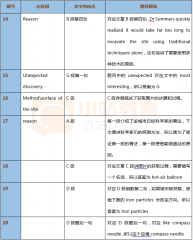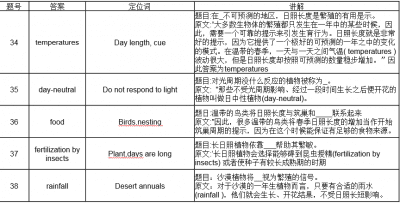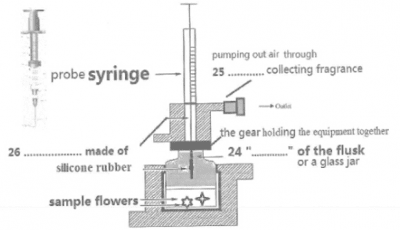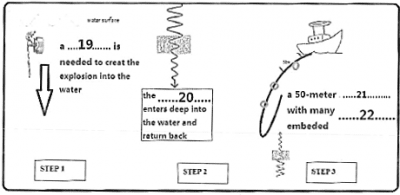雅思阅读备考不要养成坏习惯
好习惯是大家备考雅思的好帮手,而坏习惯则有可能是导致最终低分的罪魁祸首。一些同学在备考雅思阅读的时候养成了一些坏习惯却浑然不觉,有的同学则是想改也改不掉。那么雅思阅读备考中都有哪些坏习惯,又该如何戒掉呢?
做题总想看答案?雅思阅读备考不要养成坏习惯
雅思阅读考察大家的英文阅读能力,而大家在长久的英文学习中已经养成了一些阅读习惯,这些习惯有些是对雅思阅读提升有帮助的,有的则是不利于做雅思阅读题目的。下面,我们一起来看看雅思阅读备考中都有哪些坏习惯会影响大家做阅读的速度和效率。
一.遇到生词立刻查词典
遇到生词不应该查词典吗?当然应该,但是查词典也要分时间段。如果我们在雅思阅读考试中遇到了生词难道也要立刻停下来去查单词吗?既然大家要备考雅思阅读,那就应该针对阅读的要求去约束自己,雅思阅读篇幅长难度大,阅读过程中遇到生词是很正常的事情,如果立刻停下来去查生词,不仅做题效率低,还会养成依赖词典的习惯。建议大家在做阅读题的时候将词典放在一边,遇到生词先标记,影响理解的话结合上下文猜测一下词义,不影响的直接略过。等到你做完整篇或整套题目的时候再回头将所有的生词积累下来,集中起来背记。
二. 做一题看一题答案
一些心急的同学可能做完一道阅读题目立刻就想知道做的对不对,结果养成做一题对一题答案的坏习惯。雅思阅读需要大家在20分钟内完成一篇阅读的所有题目,如果大家养成这样的做题习惯,可能会忽略阅读速度导致考试中在规定时间内无法完成所有题目。另外,做一题对一题答案通常会做到后面已经忘记了前面的内容,而雅思阅读一般是从题目出发在文中找答案,不利于对文章主旨的把握。建议大家将纠错环节放在最后进行,不要做一道题看一次答案,这样不仅会导致做题效率低下,也会让大家对答案产生依赖心理。
三. 读懂文章才开始做题
雅思阅读文章很长,题目很多,不同于我们参加过的四六级或者高考英语考试。平时大家在做英语阅读的时候可能已经养成了读懂文章再做题的习惯,但若是在备考雅思阅读的时候仍然沿用这样方法可能无法在规定时间内完成所有题目,一篇雅思阅读的长度抵得上两篇多的四六级阅读文章,而且每篇文章需要完成13-14个题目。建议大家养成带着问题找答案的习惯,先花两三分钟总览各段主旨句把握文章大意,然后要根据问题定位文中对应信息快速做题。
雅思阅读备考中的一些坏习惯不仅会影响备考效率,很有可能会导致阅读低分。建议大家在阅读的时候不要一遇到生词就查词典,等到读完文章再统一整理错题;做题的时候不要做完一题就急着看答案,将纠错环节放在最后进行;最后还要养成正确的读文章习惯,先总览把握主旨,再根据问题去找答案。
雅思考试阅读模拟练习及答案
Food agency takes on industry over junk labels
Felicity Lawrence
Thursday December 28,2006
The Guardian
1.Consumers are to be presented with two rival new year advertising campaigns as the Food Standards Agency goes public in its battle with the industry over the labelling of unhealthy foods.
2.The Guardian has learned that the FSA will launch a series of 10-second television adverts in January telling shoppers how to follow a red,amber and green traffic light labelling system on the front of food packs,which is designed to tackle Britain's obesity epidemic.
3.The campaign is a direct response to a concerted attempt by leading food manufacturers and retailers,including Kellogg's and Tesco,to derail the system.The industry fears that traffic lights would demonise entire categories of foods and could seriously damage the market for those that are fatty,salty or high in sugar.
4.The UK market for breakfast cereals is worth £1.27bn a year and the manufacturers fear it will be severely dented if red light labels are put on packaging drawing attention to the fact that the majority are high in salt and/or sugar.
5.The industry is planning a major marketing campaign for a competing中华考试网(www.Examw。com) labelling system which avoids colour-coding in favour of information about the percentage of "guideline daily amounts" (GDAs) of fat,salt and sugar contained in their products.
6.The battle for the nation's diet comes as new rules on television advertising come into force in January which will bar adverts for unhealthy foods from commercial breaks during programmes aimed at children.Sources at the TV regulators are braced for a legal challenge from the industry and have described the lobbying efforts to block any new ad ban or colour-coded labelling as "the most ferocious we've ever experienced".
7.Ofcom's chief executive,Ed Richards,said: "We are prepared to face up to any legal action from the industry,but we very much hope it will not be necessary." The FSA said it was expecting an onslaught from the industry in January.Senior FSA officials said the manufacturers' efforts to undermine its proposals on labelling could threaten the agency's credibility.
8.Terrence Collis,FSA director of communications,dismissed claims that the proposals were not based on science."We have some of the most respected scientists in Europe,both within the FSA and in our independent advisory committees.It is unjustified and nonsensical to attack the FSA's scientific reputation and to try to undermine its credibility."
9.The FSA is understood to have briefed its ad agency,United,before Christmas,and will aim to air ads that are "non-confrontational,humorous and factual" as a counterweight to industry's efforts about the same time.The agency,however,will have a tiny fraction of the budget available to the industry.
10.Gavin Neath,chairman of Unilever UK and president of the Food and Drink Federation,has said that the industry has made enormous progress but could not accept red "stop" signs on its food.
11.Alastair Sykes,chief executive of Nestlé UK,said that under the FSA proposals all his company's confectionery and most of its cereals would score a red."Are we saying people shouldn't eat confectionery? We're driven by consumers and what they want,and much of what we do has been to make our products healthier," he said.
12.Chris Wermann,director of communications at Kellogg's,said: "In principle we could never accept traffic light labelling."
13.The rival labelling scheme introduced by Kellogg's,Danone,Unilever,Nestlé,Kraft and Tesco and now favoured by 21 manufacturers,uses an industry-devised system based on identifying GDAs of key nutrients.Tesco says it has tested both traffic lights and GDA labels in its stores and that the latter increased sales of healthier foods.
14.But the FSA said it could not live with this GDA system alone because it was "not scientific" or easy for shoppers to understand at a glance.
Questions 1-6
Answer the questions below using NO MORE THAN THREE WORDS from the passage for each answer.
1.When will instructions be given on reading the color-coded labels?
2.Where can customers find the red light labels?
3.What problem is the FSA trying to handle with the labeling system?
4.Which product sells well but may not be healthy?
5.What information,according to the manufacturers,can be labeled on products?
6.What can not be advertised during children's programmes?
Questions 7-13
Use the information in the text to match the people (listed A-E) with the opinions (listed 7-13) below. Write the appropriate letter (A-E) for questions 1-7.
NB You may use any letter more than once.
A Ed Richard
B Terrence Collis
C Gavin Neath
D Alastair Sykes
E Chris Wermann
7.Generally we will not agree to use the red light labels.
8.It is unreasonable to doubt if FSA is trustworthy.
9.We are trying to meet our consumers’ needs.
10.The food industry has been improving greatly.
11.The color-coded labeling system is scientific.
12.Our products will be labeled unhealthy by the FSA.
13.We are ready to confront the manufacturers.
雅思考试阅读模拟练习及答案
Answer keys:
1.答案:(in) January (见第2段:The Guardian has learned that the FSA will launch a series of 10-second television adverts in January telling shoppers how to follow a red, amber and green traffic light labelling system on the front of food packs, which is designed to tackle Britain's obesity epidemic.)
2.答案:food packs/packaging (见第2段:The Guardian has learned that the FSA will launch a series of 10-second television adverts in January telling shoppers how to follow a red, amber and green traffic light labelling system on the front of food packs, which is designed to tackle Britain's obesity epidemic. 或者在第4段中也提到另一个答案:The UK market for breakfast cereals is worth £1.27bn a year and the manufacturers fear it will be severely dented if red light labels are put on packaging drawing attention to the fact that the majority are high in salt and/or sugar.)
3.答案:(Britain’s) obesity epidemic (见第2段:The Guardian has learned that the FSA will launch a series of 10-second television adverts in January telling shoppers how to follow a red, amber and green traffic light labelling system on the front of food packs, which is designed to tackle Britain's obesity epidemic.)www.ExamW.CoM
4.答案:(breakfast) cereals (见第4段:The UK market for breakfast cereals is worth £1.27bn a year and the manufacturers fear it will be severely dented if red light labels are put on packaging drawing attention to the fact that the majority are high in salt and/or sugar.)
5.答案:guieline daily amounts/GDAs (见第5段:The industry is planning a major marketing campaign for a competing labelling system which avoids colour-coding in favour of information about the percentage of "guideline daily amounts" (GDAs) of fat, salt and sugar contained in their products.)
6.答案:unhealthy foods (见第6段第1句:The battle for the nation's diet comes as new rules on television advertising come into force in January which will bar adverts for unhealthy foods from commercial breaks during programmes aimed at children.)
7.答案:E (见第12段:Chris Wermann, director of communications at Kellogg's, said: "In principle we could never accept traffic light labelling." )
8.答案:B (见第8段最后一句:It is unjustified and nonsensical to attack the FSA's scientific reputation and to try to undermine its credibility.)
9.答案:D (见第11段最后1句:We're driven by consumers and what they want, and much of what we do has been to make our products healthier.)
10.答案:C (见第10段:Gavin Neath, chairman of Unilever UK and president of the Food and Drink Federation, has said that the industry has made enormous progress but could not accept red "stop" signs on its food.)
11.答案:B (见第8段:Terrence Collis, FSA director of communications, dismissed claims that the proposals were not based on science. "We have some of the most respected scientists in Europe, both within the FSA and in our independent advisory committees. It is unjustified and nonsensical to attack the FSA's scientific reputation and to try to undermine its credibility.")
12.答案:D (见第11段第1句:Alastair Sykes, chief executive of Nestlé UK, said that under the FSA proposals all his company's confectionery and most of its cereals would score a red.)
13.答案:A (见第7段第1句:Ofcom's chief executive, Ed Richards, said: "We are prepared to face up to any legal action from the industry, but we very much hope it will not be necessary.")





